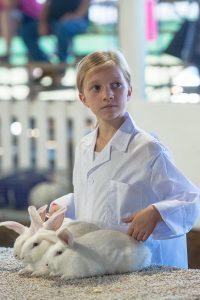The market fryer rabbit show, which is typically held in the small animal barn, was instead held in the swine arena to allow for social distancing and as much space for the spectators and the participants as possible. A strict mask guideline was issued for all people inside of the animal barns and show arenas at all times following the governor’s mask mandate and the health department’s reinforcement of that mandate.
Justin Zollars, a 16-year-old 4-H’er from Mount Vernon who is a member of the Blue Ribbon Livestock Club in Fredericktown, was among the local youth who were eager to show their hard work at the fryer show. One major component of raising a market rabbit for the fryer show is that you have to be very aware of your animal’s weight and how much feed the animal is consuming daily.
A mature market rabbit (the most popular being the New Zealand breed) should weigh around 3 to 5 pounds for a show, with 9 to 15 pounds being the total weight of the three rabbits being shown to the judge. During the show, the 4-H participant showing the animal has to line their rabbits up on a table for the judge to look at. It is ideal for the rabbits to look practically identical, and the judge looks at the stature of the animals. The judge also looks for any defects with the animal, such as a broken tail or other external problems.
Zoe McClung, a 14-year-old member of the Green Leaf 4-H club in Mount Vernon who is from Marengo, noticed some differences in this year’s fair compared to last year’s.
“Obviously the face-masks are a big difference this year as well as the limitations with the animals and the spacing out of the cages,” said McClung. “This year we also can’t hand out multiple show programs for sanitary reasons. We can only have one show program in the barn to prevent a bunch of show programs being passed around from person to person.”
Annalia Wolf, a 10-year-old member of the Green Leaf 4-H Club, got to experience her first year of the Knox County Fair. Even though the event was impacted by a pandemic, Wolf was still able to exhibit the hard work she put into her market rabbit project for 4-H.
“The hardest part of raising a market rabbit is having to let them go,” said Wolf. “It’s also really hard if one of them dies.”


